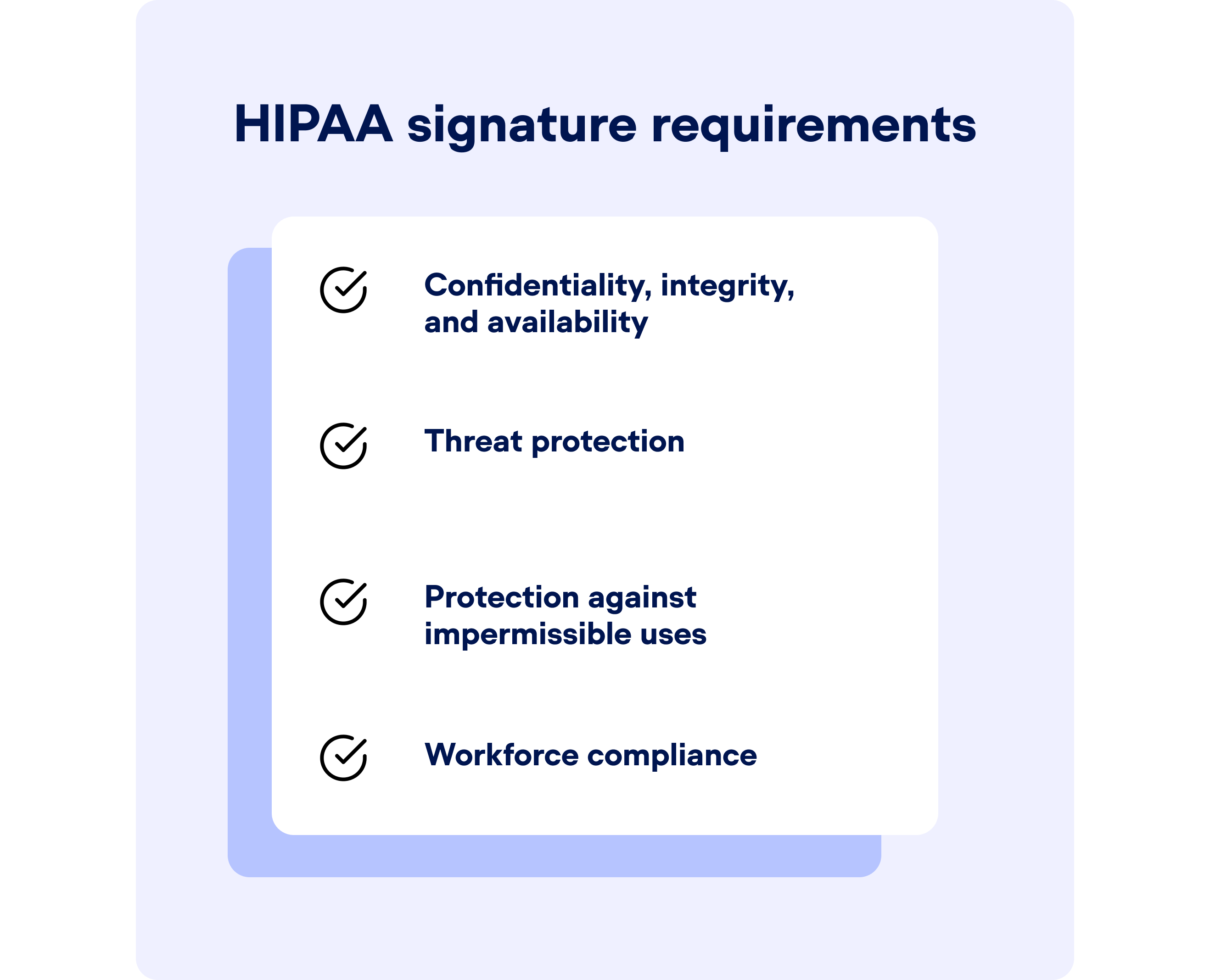HIPAA Compliant Electronic Signatures Explained
Digital documentation has become increasingly central in healthcare over the past several years. Many patients now expect to be able to sign their paperwork electronically. Meanwhile, hospitals and other healthcare providers aim to centralize data and streamline signing processes.
However, healthcare providers have to take care to collect electronic signatures in ways that comply with 1996’s Health Insurance Portability and Accountability Act (HIPAA). While HIPAA does permit electronic signatures, the law is very specific about how patient information can be collected, shared and stored. In order to comply with HIPAA, electronic signatures need to be authenticated, and the authentication data needs to be stored securely.
Here, we’ll take a closer look at what HIPAA means for electronic signatures. We’ll explore how to choose signature software that supports HIPAA compliance, and how to collect and store signatures in ways that comply with the law. Let’s dive in!
Does HIPAA allow electronic signatures?
Yes, HIPAA does allow electronic signatures. What’s more, two important pieces of federal legislation explicitly back up the legal validity of e-signatures. The Global and National Commerce Act (ESIGN Act) and the Uniform Electronic Transactions Act (UETA) both specify that electronic signatures are legally equivalent to handwritten signatures as long as they meet the following four criteria:
- Intent to sign: You need to have proof that every party intended to sign the contract in question.
- Consent to do business electronically: You need to be able to show that all parties consented to engage in an electronic transaction. Many contracts achieve this by including an electronic signature clause, which states that the parties agree to do business electronically by signing the document.
- Association between signature and record: An e-signature needs to include an audit trail, documenting who signed and when. This trail is often auto-generated by software.
- Record retention: Electronic signatures need to be stored in a way that they can be shown on demand.
Any signature that meets the above criteria is considered legally binding under the ESIGN Act and the UETA, which means that signature can be used on HIPAA-compliant documents.
Requirements for a HIPAA compliant electronic signature
Although HIPAA doesn’t provide any specific guidelines about signatures or contract automation, the law is very particular about the security of information associated with those signatures. The HIPAA Security Rule requires all healthcare providers to take steps to safeguard Protected Health Information (PHI), such as patients’ medical details and insurance info.

Based on the HIPAA Security Rule, the main HIPAA signature requirements are:
- Confidentiality, integrity, and availability: E-signatures must restrict unauthorized access, offer tamper-proof features, and provide reliable data backup.
- Threat protection: Implement encryption, multi-factor authentication, and regular security assessments.
- Protection against impermissible uses: Utilize robust audit trails, fine-tuned access controls, and automatic logoffs to ensure data is shared appropriately.
- Workforce compliance: Prioritize regular training, establish clear policies, and enforce sanctions for non-compliance to ensure staff handle PHI securely with e-signatures.
Let’s take a more in-depth look at how organizations can fulfill the technical requirements necessary to meet these four criteria.
Technical requirements
When integrating e-signatures into systems handling PHI, you’ll need to ensure that the system provides the following four key features:
- Legally binding signatures: Signatures collected in the software should comply with the ESIGN Act and UETA requirements outlined above, making them legally equivalent to handwritten signatures.
- Audit trails: Any interaction with the document, such as viewing, signing or altering, should be tracked, timestamped, and logged. This provides a clear record of the document’s lifecycle, and is essential for transparency.
- Authentication and verification: Tools like multi-factor authentication, SMS codes, or biometric verification ensure that signers are who they claim to be, upholding the document’s credibility.
- Encryption: Beyond standard encryption, consider end-to-end encryption, which ensures that patient information remains secure both in transit and at rest. This will help prevent data breaches and unauthorized access.
Complying with these technical requirements will provide a strong foundation for HIPAA-compliant e-signatures, protecting both your organization and your patients.
Policy and procedure requirements
When implementing e-signature solutions, it’s not just about technology but also the policies and procedures that ensure consistent and compliant behavior:
- Business associate agreements: Before collaborating with third parties or vendors, it’s essential to secure Business Associate Agreements (BAAs). These contracts ensure these external entities meet HIPAA standards when dealing with PHI.
- Training and management: Regular training is paramount. Everyone involved, from staff to associates, should be well-versed in the specifics of HIPAA-compliant electronic signatures, understanding both the technology and the legal implications.
- Regular audits and assessments: Consistent monitoring is crucial. You should routinely evaluate your organization’s compliance with the standards set by the Department of Health and Human Services. Audits will help highlight vulnerabilities and areas for improvement, ensuring that systems and procedures remain up to date.
Establishing and maintaining stringent policies and procedures is just as vital as the technology itself. The goal is to create a holistic environment where patient data remains protected at all times.
How to choose HIPAA compliant electronic signature software
The most effective way to choose HIPAA compliant e-signature software is to consider both “must-have” features and other important factors, such as training and support.
Features to look for in signature solutions
When selecting an e-signature solution, especially in the healthcare sector, it’s important to prioritize certain features to ensure security, usability, and compliance:
- Robust security: Your solution should employ strong security, including a minimum of 256-bit encryption, HTTPS access, and single sign-on (SSO)
- User authentication: You’ll need to ensure that only authorized individuals can sign or access documents. That means your software should authenticate every e-signature, and should protect all users’ accounts with multi-factor authentication.
- Integration with other systems: Your software should be versatile enough to seamlessly integrate with existing systems, whether they’re Electronic Health Records (EHRs) or administrative tools in hospitals and clinics.
- Ease of use: The platform should be intuitive. Users shouldn’t need extensive training to navigate it. A user-friendly interface reduces errors and boosts efficiency.
- Comprehensive audit trails: Beyond just tracking signatures, the solution should log every single interaction with the document, from viewing to editing. This will ensure transparency and accountability.
- Clear and flexible pricing: Your solution should offer a pricing model that’s easy to understand, and that’s flexible enough to scale with your organization.
By focusing on these features, you’ll be able to zero in on a software solution that’s both compliant with HIPAA and versatile enough to fit into your existing workflows.
Factors to consider beyond software
While software features are paramount, you’ll also want to consider the following external factors when selecting an e-signature solution, particularly for healthcare:
- Reputation: You’ll want to investigate the credibility of each software provider. Look for user reviews, expert opinions, and any accolades or endorsements they might have received. A proven track record can provide assurance of reliability.
- Training and support: Your software should include dedicated support, as well as personalized training sessions. These will serve as opportunities for your team members to ask questions, walk through workflows, and make sure they stay in compliance.
- Secure data policies: Take a look at the software’s terms and conditions, and make sure you understand what liabilities they cover, especially in case of a breach. Ask about their data deletion and retention policies, as well as data subject rights.
- Business Associate Agreements (BAAs): Your software provider will become a Business Associate, under HIPAA’s definition, as soon as you place PHI on their platform. The vendor may need to complete a BAA agreement before you can legally use their software.
Remember, HIPAA compliance depends not just on the technology, but also the ecosystem around it. All these factors will help you choose a responsible and compliant partner.
Recommendations
A wide variety of e-signature solutions are available today, and several stand out for their robust HIPAA-compliant offerings. Here’s a glance at several popular choices:
- Concord: With flexible pricing, bank-level security, and robust training, this solution offers end-to-end healthcare contract management, including authenticated e-signing.
- DocuSign: A recognized name in the electronic signature sector, DocuSign has made considerable strides to ensure HIPAA compliance.
- Adobe Sign: Adobe’s foray into electronic signatures offers advanced user authentication tools, demonstrating a commitment to HIPAA regulations.
- Dropbox Sign: Known for its user-friendly interface, HelloSign provides a seamless integration experience with many healthcare systems.
- SignNow: This platform offers comprehensive audit trails and user authentication. These features make it a viable option for healthcare institutions of varying sizes.
While each of these solutions has its strengths, it’s worth keeping in mind that e-signatures alone won’t guarantee HIPAA compliance. For that, you’ll need a comprehensive plan for contract lifecycle management. Check out Concord’s guide to healthcare contracts and management for tips on how to put a plan into action.
Choosing the right HIPAA compliant e-signature solution requires some due diligence. You’ll want to select a platform that keeps you in compliance with robust security policies, including authentication for users and signers. And by making that platform part of an organization-wide contract management strategy, you’ll be able to safeguard your patients’ data even more proactively, and build trust that’ll keep your organization growing.




